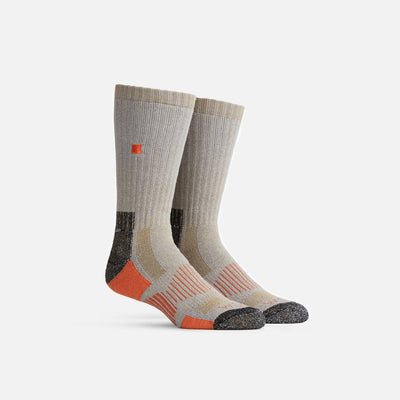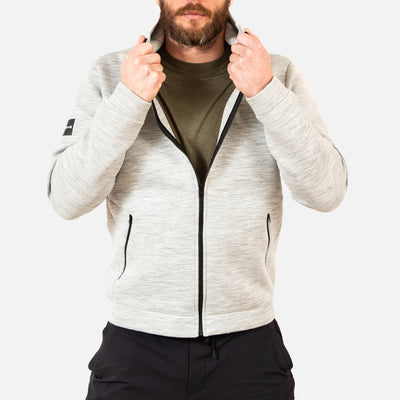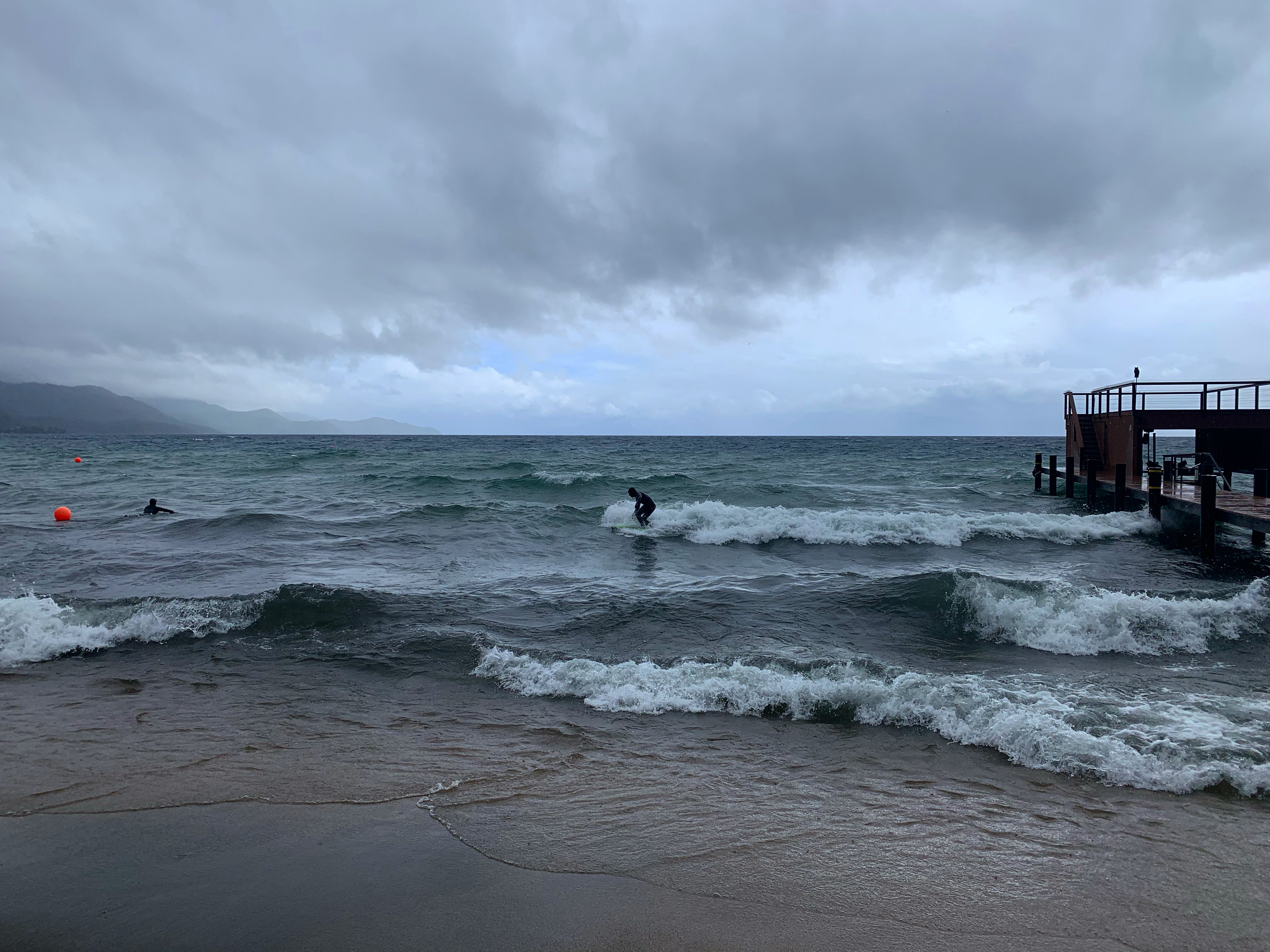The Unlikely Surf Destination - Lake Surfing With Ambassador Aurelien “Frenchy” Bouche-Pillon

The first thing that comes to mind for most people when you talk about surfing probably isn't a large land-locked body of water. Before Kelly Slater's wave pool, we generally associated surfing with oceans, and maybe even beyond that with warm, sandy beach locales. Wake-surfing behind a boat or taking a turn on a standing wave amusement park ride have served as the poor man’s substitute for many years, but these options do a poor job of mimicking the real thing.
When I moved to Lake Tahoe some years ago from New England I was excited just to have the infamous breaks of Santa Cruz within driving distance, and the amazing alpine lake scenery didn’t hurt either. Shortly after I arrived, I began hearing stories about surfing on the lake; how a big storm could bring in heavy winds and make surfable waves. I was always amazed when I happened to witness white caps and actual wave faces while driving around the lake on windy days, but I knew this type of swell would be choppy and chaotic from days of hurricane surfing. I had learned that the wind had to be about 30 plus mph to make reliable waves, which typically happened during winter storms while I was more interested in hitting the slopes. It never seemed to line up at the right time for me so I wrote it off as a novelty that probably wasn’t even worthwhile.
Nearly five years passed before I finally got the chance to go during a spring day, and thanks to working at home because of quarantine I had the flexibility to load up my gear and go check it out. I drove 45 minutes to a spot my more experienced lake surfing friend had scoped the best waves and proceeded to do my usual cold water surf prep routine – pulling on layers, my thickest suit, my thermal Worn Frictionless Socks and Second Skin Gloves, 7mm booties and mittens and the dreaded wetsuit hood. The wind fought me as I made my way to the water, whipping around as I tried to push my way to the lake’s edge but once I was in the water it felt good to be paddling despite the chop. We spent about two hours constantly paddling to stay in the right zone and I wouldn’t say I caught the best rides of my life, but it was really surfing and the mountain views in and of themselves were worth the effort. The absurdity of it had my crew laughing and smiling as we caught our short, but exciting rides in the crystal blue water.
After experiencing the fruits of my new “home break”, I hopped on the phone with Worn ambassador Aurelien “Frenchy” Bouche-Pillon to learn more about why someone might even choose lake surfing over the ocean, and how the surfing culture on the Great Lakes has evolved in the past 14 years he has been there:
Ariel: Tell me a little about yourself, where you live and what got you into surfing?
Frenchy: I’m upstate New York in Rochester, on Lake Ontario. The Great Lakes is a huge area, there’s so much fresh water and so much diversity to the land scape. I’m across from Toronto, there’s five Great Lakes, obviously, and it’s the biggest fresh water reserve on the planet so it’s not to take lightly. I live on the smallest lake, Lake Ontario, but it’s still pretty deep at 300 feet and there’s so much history around it with the French and British. It was discovered by a French explorer so I sometimes I just feel so connected – I’m from France. I’ve lived here 14 years now, I came with no English and no knowledge of America or the Great Lakes and I came with two surfboards. I didn’t even know you could surf on the Great Lakes so I thought I would stop a little bit here then go to California, and then I’m actually living my surfing dream on a lake. It’s kind of interesting.
Ariel: Did you grow up surfing on the ocean?
Frenchy: My dream as a child was always to surf, I just wanted to surf. I was born on the Mediterranean sea, but was living far from the ocean and I was just dreaming of surfing so I would go every year on the ocean in France where we have very consistent waves. Then when I was old enough to be independent and financially make my own decisions I moved to the ocean and surfed every day. I actually surfed every day and couldn’t handle a job!
Ariel: It’s hard to have that balance, sometimes it doesn’t line up with the hours of a job.
Frenchy: That is right, and that’s why I’ve never wanted to have a job! I have income and I work, but I do everything remotely and independently, it’s the only way. Especially living on the Great Lakes you have to be on top of the forecast and you have to be flexible, it’s so fickle. There’s no way if you have an 8 to 5 job.
Ariel: Yeah, I actually only recently surfed on Lake Tahoe because what always happened to me was when the storms would line up and the wind would be good, I would be busy or working or something else would be going on and you have to just be able to go super last minute. Even the days when you think maybe there’s enough wind, you still have to be flexible – you might drive to the lake and find that it’s not hitting quite right. There’s no surf cams like there are on the ocean so you have to just wing it a little bit.
Frenchy: I know the feeling. I want to surf Lake Tahoe on a big day, it’s on my bucket list.
Ariel: I surf on the ocean frequently and I had seen lots of photos of people surfing on the lake but I had never had the chance, so when you’re out in the water you’re just kind of amazed that this lake that can be so calm and glassy and beautiful can have these head high waves on another day! But we have the same challenge you do which is that we have to get a certain amount of wine, it has to be the right direction. For Ontario, since it’s slightly larger, what are the ideal conditions there and what do you look for for a day to know that it’s going to be surfable?
Frenchy: It’s different depending on where you are. There are breaks that can surf every wind direction here. Where I live a Northwest wind is very rare so I have to commit to a lot of driving to get it on those days, but I got that nailed down. Realistically, I spent the past 14 years exploring and putting on a lot of miles to really understand Lake Ontario and the 3 other lakes around me, so I get to surf a lot. Surprisingly, I have a lot of pro surfer friends from the ocean that sometimes see my pictures and say I actually surf more than people living on the east coast.
Ariel: You surf that frequently? It’s consistent enough that you can go that often?
Frenchy: Yeah, actually this spring has been insane – with very cheap gas and less professional activity and no restrictions on Lake Ontario (on my side at least), I was able to surf 3 or 4 times a week for 2 months straight.
Ariel: Does the summer seem to be calmer? Do you have seasons with better surf? I know for us here it seems that the winds line up in the winter with be gales and storms.
Frenchy: 100 percent, it’s super seasonal. There’s an extreme weather change and pattern between summer and winter. Winter we surf in minus 20 or 30 degrees with giant wind storms, and then summer is super warm up to 90 degrees. But we get a lot of west winds and if you’re willing to drive a little bit we have some fun beach breaks that give you three footers in the summer, so you can actually surf in the summer. You can actually surf year-round and what I love about it is that there are plenty of opportunities to discover new places. Especially where I live because most of the most of the Great Lakes are really well-populated and people surf, but where I live I never really surf with anyone else than a friend.
In regards to the weather, climate change realistically creates more intense storms. The Great Lakes are more subject to climate change than anywhere else in the US based on the fact that those bodies of water create micro climates. We get lake effect snow, you can be driving on a sunny day with no clouds and within 10 minutes a wind storm and snow storm will come in and you can’t see 100 feet away. Then you pass that snow band and you’re back into sun. The lake can be flat and you can get six foot waves within two hours. So there’s so much power in this body of water. It’s more intense every year and we are getting more and more waves.
You have to do the best with where you are and it’s pretty magical to be able to surf on a lake.
Ariel: Yeah, when it happens here it’s definitely a special experience. There’s a small amount of people out of the population here that actually get out and surf when it’s windy so there’s this kind of tight-knit community of hardcore surfers that go and do this. I’m sure there has to a unique community there as well?
Frenchy: It’s growing a lot and I’m very involved with the surfing community in business and personally and the growth is beautiful. It’s also nerve-wracking because it’s a hard balance to find between promoting the sport and protecting the environment and places that are unique, to keep some freedom to surf in spaces where there’s not too many people. I sell wetsuits and by selling wetsuits I’m encouraging people to go in the water and that’s beautiful but then it’s harder to surf on your own.
Ariel: So when you surf on the lake what info do you use to pick your surf spot? Do you have surf forecasting there? What helps you pick where you surf?
Frenchy: We have a lot of resources that can help you but only experience really tells you what the waves are going to do. Computers and technology doesn’t always work – sometimes they forecast something that doesn’t really happen and sometimes they don’t forecast and the lake does its own magical thing. It’s really about commitment, passion and time. We have webcams in some places, websites that give you the wind direction, buoys that are only in the summer because in the winter the lake can freeze. You have to rely on your experience and you have to search. Last time I drove two hours and surfed overhead waves by myself while my buddies surfed a close spot on two foot waves. It takes time.
Ariel: Do you have any tricks you use to stay warm enough and what gear do you use?
Frenchy: I’m a gear freak, I will say that the Frictionless Socks are absolutely a must and I’m a big advocate of them. They are a huge deal to stay warm and get in and out of your suit as a cold water surfer. You also want thick suits, Vaseline on the face, ear plugs. A car with heated seats in huge and the Rinse Kit with hot water is great. Warm up on the beach regardless of the conditions to get the blood circulating. Keep active in the water paddling, but we don’t have a choice because it’s wind driven, so we have to keep moving. Having another suit and booties and gloves in the car and of course a big thermos so you can drink warm fluids before and after. Protein bars and nuts - you need to also keep fueling your body that is consuming so many calories in the cold.
Ariel: There’s something to be said about the commitment it takes to surf a lake, people might try it, but I don’t think everybody is going to become someone that does it every day.
Frenchy: That’s my fall back mind set, I don’t think anyone will commit as much as I do so I always have a spot to on my own so I shouldn’t worry. You hunt for storms and waves and you have to earn it – I spent all these years driving thousands of miles and spent hundreds of hours studying and searching and driving in snow storms when it’s dangerous. Connecting with property owners to go around and find a break, and I’ll post a picture and someone will come and ask “where is that?”… there’s no way I will say where it is. I always tell people you have to find it.
It can also be beautiful to also share the content and make other people dream. What I truly enjoy is I have so many people, regardless of age or gender or background, that surf or don’t surf, that reach out to me all the time and say “Thank you so much for sharing those pictures because we rediscovered where we live. Now we don’t complain about the winter because we see there are people enjoying it.” That’s amazing.




















